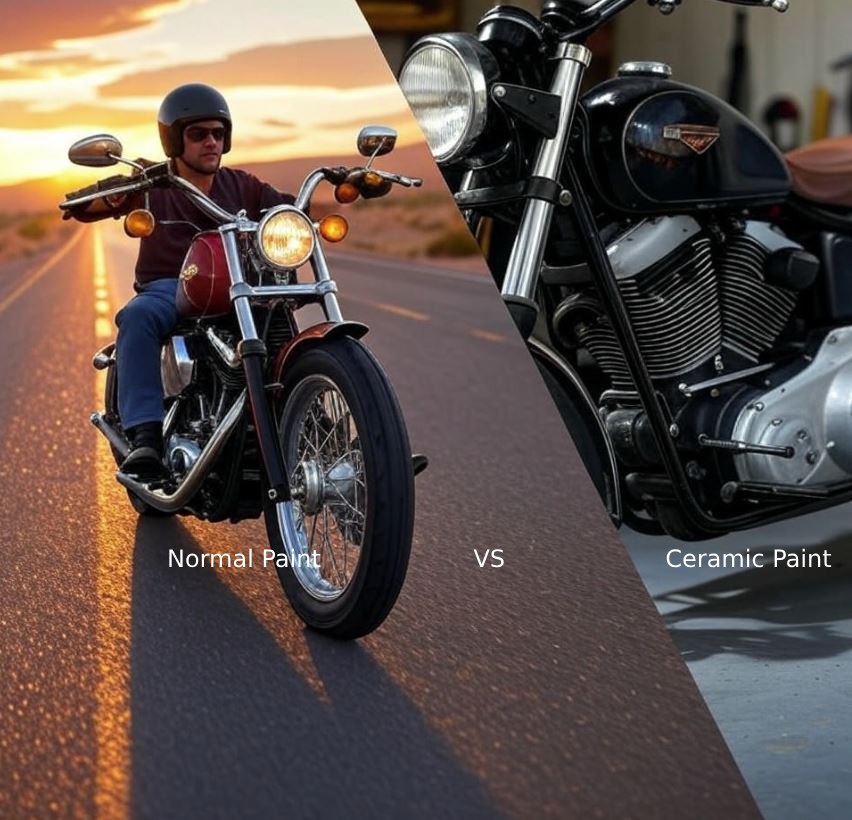- Posted on
- • Performance
How Do Ceramic Coatings Improve Vintage Motorcycle Restorations?
- Author
-
-

- User
- Torque
- Posts by this author
- Posts by this author
-
How Do Ceramic Coatings Change the Game for Vintage Motorcycle Builds?
If you've spent any time in a garage restoring old iron—especially bikes that most people would call "junk"—you know how tough it is to get everything looking sharp without sacrificing function. I've worked on everything from BSA Gold Stars to Norton Commandos, and I've seen the struggle firsthand: corrosion creeps in, chrome fades, paint chips, and engine parts get scorched by heat.
Test Your Motorcycle Knowledge
Lately, I've been getting into ceramic coatings—not because they sound flashy or like something out of a sci-fi movie, but because they actually do something. These aren't just some gimmicky spray-on miracle or buzzword BS you see floating around online. We're talking real results here—noticeable gains in how long your paint holds up, how clean your engine stays, and even how your bike runs when things aren't baking under their own heat.
Whether you're slapping together a no-frills barn find for weekend rides or sweating the details on a show-stopper build, ceramic coatings are becoming one of those tools you don't want to skip. It's not about going full NASA on your old iron—it's about giving it a fighting chance against time, weather, and the road.
What Makes Ceramic Coatings Different From Traditional Paint or Powder Coat Finishes?

Let me break this down with something we all understand: heat. Vintage engines weren't built with thermal efficiency in mind. They ran hot, especially air-cooled twins and singles. That heat eats away at your paint, warps your metal, and ages your components faster than rust sometimes.
Traditional paint and powder coating offer some protection, sure. But they don't really fight heat—they just sit there and take it until they crack, peel, or blister. Ceramic coatings, on the other hand, actively reduce surface temperatures. Some formulations can drop temps by as much as 50–70°F (10–20°C), depending on application and exposure.
I remember working on a '72 CB750 that had melted its side covers after years of baking under a black plastic tank. After applying a ceramic heat barrier inside the fairing and on the exhaust headers, the difference was night and day. No more warped plastics, no more blistered paint jobs—it looked cleaner longer and held up better through the summer rides.
Can Ceramic Coatings Protect Against Corrosion Like Traditional Sealants?
Absolutely—and then some. Corrosion is the silent killer of vintage machines. It starts small, maybe a little pitting around a bolt hole or a patch of surface rust under the seat. Left unchecked, it becomes a full-blown structural nightmare.
Most guys reach for POR-15 or a zinc-rich primer. Those still have their place. But what if you could not only stop corrosion in its tracks but also add a protective layer that repels moisture?
That's where ceramic comes in. The molecular structure of ceramic coatings creates a hydrophobic surface—water literally beads up and rolls off. This means less moisture sitting on your frame tubes, engine cases, or swingarm pivot points. I've used ceramic-based anti-corrosion sprays on brake calipers, chain tensioners, even battery trays. In humid climates like Florida or the Pacific Northwest, where I've helped rebuild bikes for clients, these coatings have made a huge difference in long-term preservation.
One guy I know restored a '69 Triumph T120 that sat outside for ten years. He coated the inner frame rails with a ceramic-infused anti-rust formula before assembly. Two years later, no signs of surface rust. That's unheard of for a bike that used to live under a tarp.
Do Ceramic Coatings Improve Engine Performance During Vintage Motorcycle Restoration?
This might surprise you—but yes, they absolutely do.
Here's the deal: when you're rebuilding a vintage engine, chances are you're sticking pretty close to stock specs. And let's be real—those old engines weren't exactly built for the track. A lot of them ran hot in places that mattered most—like the combustion chamber, exhaust ports, and cylinder heads. That heat doesn't just hang out; it soaks into the metal, which can sap power and wear components down faster than you'd think.
Now, here's where ceramic coatings come in handy. When you lay them down on piston crowns, inside the combustion chamber, or along the exhaust headers, you're basically creating a heat barrier. That means more of the heat from combustion stays where it should—in the burn—and less of it bleeds into the surrounding parts.
What does that get you? Better heat management, cleaner combustion, and less chance of knocking or detonation. And yeah, it can actually give your horsepower a little nudge too—sometimes 3 to 5 percent, even on smaller engines. Not enough to make your old twin sound like a GP bike, but definitely enough to feel the difference when you twist the throttle.
I did this on a '74 Yamaha XS650 café build I was working on last year. The owner wanted something reliable but punchier off the line. We coated the piston tops and the inside of the combustion chamber. Not only did it run smoother, but oil temps dropped noticeably, which meant fewer oil changes and less wear over time.
Are Ceramic Coatings Worth the Cost for Vintage Motorcycle Restorations?
I won't lie—ceramic isn't cheap. A full engine and exhaust treatment can run you $800–$1,500, depending on the shop and the complexity of the job. For some folks restoring a budget bike, that's a hard pill to swallow.
But here's how I see it: if you're investing thousands into a frame-up rebuild, spending a few hundred extra bucks to preserve that work makes sense. Especially if you're planning to ride it regularly or show it off at events.
Plus, think long-term. Ceramic coatings last longer than paint. You won't be touching up faded valve covers every couple of years. And if you ever sell the bike, that kind of detail doesn't go unnoticed. I've seen restored bikes with ceramic-treated parts fetch higher prices at auctions simply because of the added layer of sophistication and protection.
How Do Ceramic Coatings Hold Up to Daily Riding and Weather Conditions?

Real talk: vintage bikes aren't always practical. They vibrate, they leak, and they need constant attention. But if you're building one to actually ride, not just polish in your garage, you want it to survive more than a summer parade.
Ceramic coatings are tough. Scratch-resistant. UV-stable. And unlike clear coats or wax, they don't degrade after a few washes or sunbathing sessions. I've had bikes treated with ceramic engine coatings that went through Midwest winters and Southwest summers with minimal fading or wear.
One buddy of mine commutes year-round on a '78 Honda CBX that he fully ceramic-coated during the rebuild. He hits 10,000 miles a year, through rain, snow, salt, and grime—and the engine still looks fresh two years later. That's saying something.
Where Can I Find Quality Ceramic Coating Services for My Vintage Motorcycle?
Not all shops are created equal. You want someone who understands both vintage bikes and ceramic applications. Don't just Google "ceramic coating near me" and hope for the best. Look for specialty restoration shops that either offer in-house ceramic treatments or partner with trusted vendors.
You'll notice a lot of high-end custom shops are now throwing ceramic coatings into their top-tier builds—it's becoming pretty standard if you're paying for a full nut-and-bolt restoration. But here's the good news: you don't have to write a blank check to a builder to get in on the action.
If you're the type who likes doing the work yourself (and let's face it, most of us are), companies like Cerakote, Jet-Hot, and Thermal Tech make DIY kits that are totally doable for the home mechanic. They've got everything from spray-on formulas to detailed how-to videos made specifically for motorcycles—no industrial oven or fancy equipment required. I've seen guys knock out full engine treatments in their garage over a weekend with nothing more than a compressor and a steady hand.
Also, check out forums like Jockey Journal, Cafe Racer Forum, or Vintage Bike Enthusiasts on Facebook. Folks in these communities share real experiences, vendor recommendations, and even discount codes. I found a great local coater through a post on Britbike.com—saved me time and money versus shipping parts across the country.
Final Thoughts: Are Ceramic Coatings the Future of Vintage Motorcycle Restoration?
In my opinion? Yeah, they are. Not because they replace the soul of a vintage machine—but because they help preserve it.
Ceramic coatings aren't about hiding the patina or making something look artificially new. They're about protecting the heart of the bike while letting it age gracefully. They let us keep running cast iron engines without worrying about them disintegrating. They give us peace of mind when we park our pride and joy outside at a diner or a rally.
So if you're knee-deep in a project right now—or thinking about starting one—don't overlook what modern tech can bring to the table. Sometimes, the best way to honor the past is to protect it with the future.
Ceramic Coatings vs. Traditional Finishes: A Technical Comparison
| Feature / Property | Ceramic Coating (e.g., Cerakote, Jet-Hot) | Powder Coat | Standard Paint (Enamel/Lacquer) | Chrome Plating |
|---|---|---|---|---|
| Heat Resistance | Up to 1600°F (depending on formulation) | Up to 400°F | Up to 250°F | Moderate (prone to blistering near exhausts) |
| Corrosion Protection | Excellent (hydrophobic barrier formed) | Good | Fair | Poor to Moderate (scratches expose metal) |
| Durability / Lifespan | 10+ years (with proper application) | 5–8 years | 2–5 years | 3–7 years (without care) |
| Scratch Resistance | High (harder surface finish) | Moderate | Low | Very Low |
| UV Stability / Fade Resistance | Excellent | Good | Poor | Moderate |
| Surface Preparation Required | Medium to High | Medium | Low | High |
| Application Method | Spray or dip (oven curing required) | Spray (oven cured) | Brush/spray (air dry or bake) | Electroplating |
| Aesthetic Options | Wide range of colors and textures | Wide range of colors | Limited | Classic chrome shine only |
| Cost (per component) | $$–$$$ | $–$$ | $ | $$$ |
| Engine Performance Impact | Positive (reduces heat transfer loss) | Neutral | Neutral | Neutral |
| DIY-Friendly? | Yes (kits available) | No (requires oven cure) | Yes | No |
Now go fire up that engine, throw a leg over, and ride like hell.
